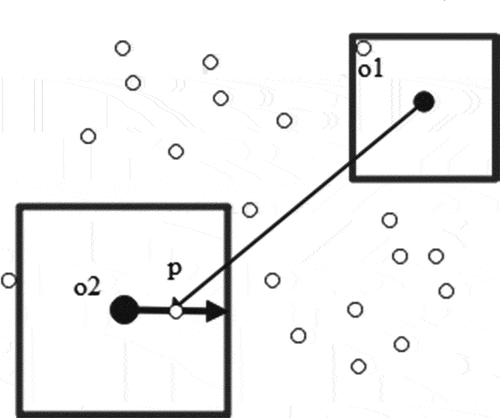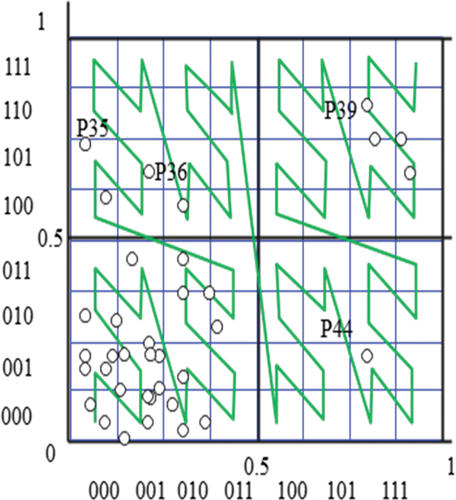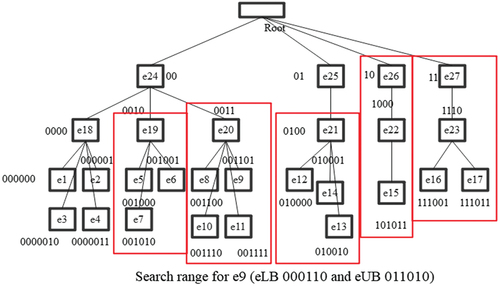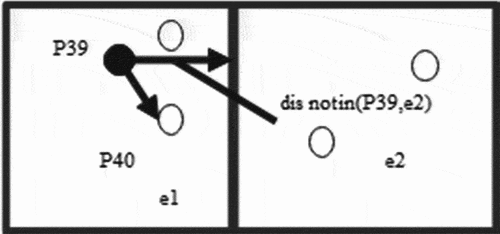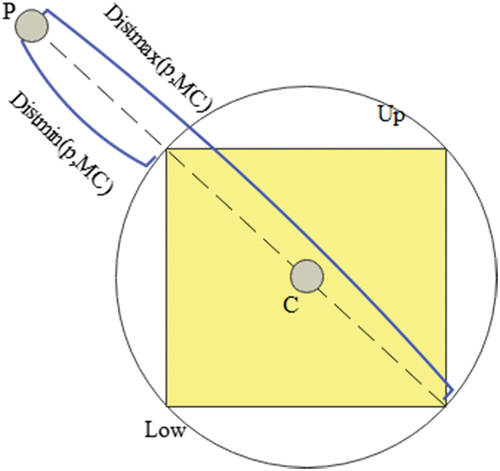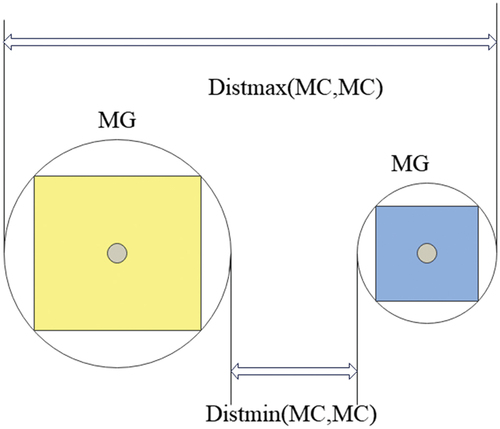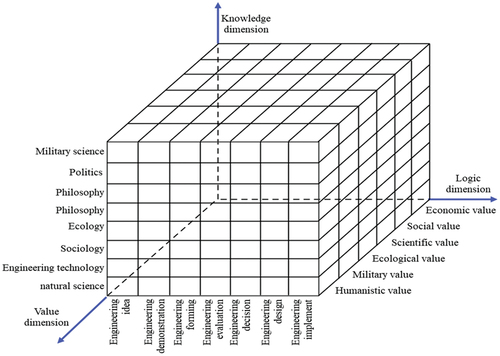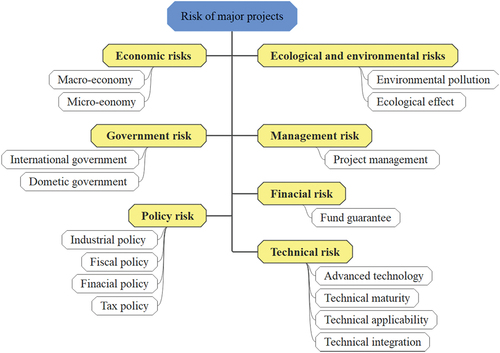 ?Mathematical formulae have been encoded as MathML and are displayed in this HTML version using MathJax in order to improve their display. Uncheck the box to turn MathJax off. This feature requires Javascript. Click on a formula to zoom.
?Mathematical formulae have been encoded as MathML and are displayed in this HTML version using MathJax in order to improve their display. Uncheck the box to turn MathJax off. This feature requires Javascript. Click on a formula to zoom.ABSTRACT
In order to improve the decision-making effect of regional economic development, this paper analyzes the decision-making model of regional economic development in combination with the engineering management process, and proposes a density-based outlier detection algorithm. Moreover, this paper analyzes the process and characteristics of the LOF algorithm, adopts the ZH-tree index structure based on the space filling curve, and improves it appropriately. The clustering feature can help to quickly search for neighbors of objects, and the hierarchical structure can perform effective spatial pruning to reduce unnecessary computation. The experimental research shows that the decision-making model of regional economic development based on the intelligent analysis of project management proposed in this paper can effectively improve the decision-making effect of regional economy.
Introduction
In today’s information age, due to the in-depth development of economy, society and science and technology (Mann Citation2018), the problems people face in production, life and scientific and technological activities are becoming more and more complex (Sigala et al. Citation2019), and the depth and breadth of the problems are getting higher and higher. The further development of science and technology has formed serious constraints (Peters et al. Citation2020). In order to meet the challenges of the times, break through the bottleneck constraints in economic and social development, and achieve a partial transition to drive the leap of the entire productive force, a country or region will actively develop key technologies that have a major driving effect on the economy, society or science and technology and have independent intellectual property rights (Flyverbom, Deibert, and Matten Citation2019) or product, the decision to initiate a major project. A major project refers to a project with huge investment scale, complex technology, long construction period, complex problems (Morrissey Citation2020), and whether its decision is correct or not will have a profound impact on the economic and social development, ecological environment, and even political and military development of a country or region (Yang Citation2020), is a strategic project organized and implemented by a country in response to major challenges to exercise the highest administrative power and mobilize the resources of the whole society. Major projects are not only the achievements of human beings in understanding and transforming nature, but also the results of rational thinking about their own future development. They have relatively long-term social and historical influence. The decision-making of major projects is not only faced with scientific and technological problems, but also needs to fully consider related issues in economy, society, population, ecology, philosophy, and even politics, military and other aspects, so it is a process of integrating multiple thinking (Andronie et al. Citation2019). The decision-making of major projects is often not based on the consideration of a single goal, but is aimed at obtaining multiple comprehensive values such as economy, society, science and technology, and ecology. The decision-making of major projects is a complex system engineering and a dynamic evolution process of the comprehensive integration of multiple thinking and multiple values (Alkhalil et al. Citation2021). When making a major project project decision, due to the complexity of the problem, the dynamic and uncertainty of the environment, the extensive and far-reaching impact on the economy and society, the incompleteness of decision-making information, the limited rationality of decision-makers and other factors, making the decision-making of major projects much more difficult than general projects. It is difficult to achieve the expected goals by relying on the major engineering decisions of a few decision makers. Only by relying on an expert group composed of experts in related fields to assist decision-making and integrating the wisdom of the group can good decision-making results be achieved. The decision-making of major projects involves not only the decision-making system and mechanism level, but also the decision-making technology level (CHOI, KIM, and KIM Citation2019). Therefore, the decision-making mode of major projects is decomposed into two levels: decision-making mechanism and decision-making technology, research the decision-making mechanism of major projects, build models for key issues and propose corresponding solutions, study typical cases of major project decision-making, build a case library, and finally It is of great theoretical and practical significance to form a major project decision-making model to provide a theoretical Literature for the scientific, democratized and institutionalized decision-making of major projects (Yang, Li, and Xu Citation2018).
Decision-making is always carried out under a certain mechanism. The design of decision-making mechanism is an important task in the decision-making mode of major projects. A reasonable decision-making mechanism can ensure the stability of engineering decision-making procedures and the scientificity of decision-making results. In terms of the basic concepts of major engineering projects, the literature (Wei and Yang Citation2019) analyzed the characteristics of major scientific and technological projects such as innovation, exploratory nature, openness, timeliness and sustainable development, and taking scientific and social benefits as the main test criteria. Literature (Zhenjian, Jiahua, and Yunbao Citation2021) studies the decision-making mechanism of public investment construction projects, analyzes the composition of decision-making bodies, the role of public participation and expert consultation, and proposes an evaluation system for decision-making mechanisms for public investment construction projects. Literature (Jing and Li Citation2020) studied the evaluation of project management capabilities of major engineering project teams. Based on the project management maturity model, the life cycle of major national defense projects, and the International Project Management Association Project Manager Capability Benchmark (ICB), a national defense major project was constructed. An index system for evaluating the maturity of project management capabilities of engineering project teams. Literature (Hou and Chen Citation2021) designed an interactive discussion mechanism for group decision-making problems such as politics, economy, and environment to integrate individual pLiteratures to form group decision-making, and proposed self-consistency and generalized self-consistency decision rules in group decision-making. From the perspective of value, literature (Davies, Kovacova, and Valaskova Citation2020) proposes a decision-making meta-value conceptual model based on system theory, and believes that decision-making is the value connection behind cognition and processing problems. Literature (Davide and Cesare Citation2018) proposed the concept of complex decision-making mode from a system perspective, and analyzed its conceptual framework from three levels: thinking and belief level, decision-making knowledge premise level, and decision-making method step level. Literature (Baur et al. Citation2020) analyzes the theoretical basis for constructing a consultative decision-making model based on modern democratic theory, analyzes the restrictive factors that hinder the establishment of a consultative decision-making model, and proposes ideas and countermeasures to promote the effective operation of the consultative decision-making model. The decision-making mode is essentially the design of the decision-making mechanism. Most of the above studies are carried out from a static perspective, and do not reflect the dynamic complexity of major engineering decisions.
Smart specialization is an approach to regional economic development that focuses on identifying and developing a region’s unique strengths and competitive advantages in specific areas of specialization. The idea is to concentrate resources and investment in areas where a region has the potential to excel and to create a competitive edge in the global market.
The smart specialization approach involves a process of identifying a region’s key economic drivers, its technological capabilities, and its research and development strengths. This process helps to identify areas where the region has the potential to develop a competitive advantage.
Once these areas of specialization have been identified, strategies are developed to support innovation and investment in these areas. This might involve investing in research and development, creating innovation clusters, or developing new products or services that leverage the region’s unique strengths.
The smart specialization approach is often used in conjunction with other regional economic development strategies, such as improving infrastructure, creating business-friendly environments, and developing a skilled workforce.
One of the key benefits of smart specialization is that it allows regions to differentiate themselves from their competitors and to develop a unique selling proposition that can attract investment and create jobs. It also helps to ensure that resources are targeted to areas where they are most likely to have a significant impact on economic growth.
Smart specialization has been successfully implemented in a number of regions around the world, including in Europe, where it has been a key part of the European Union’s regional policy framework.
The triple and quadruple helix are concepts that describe collaborative models of innovation and economic development, involving multiple stakeholders in the innovation process. These models recognize that innovation is not just the responsibility of private industry or government, but rather a collaborative effort that involves a range of actors including academia, civil society, and end-users.
The triple helix model involves three stakeholders: academia, government, and industry. In this model, academia provides the research and knowledge base, government provides the regulatory framework and funding, and industry provides the market and commercialization expertise. The model is based on the idea that these three actors can work together to generate economic growth and innovation.
The quadruple helix model expands on the triple helix by adding a fourth stakeholder, civil society. This includes a range of actors such as non-governmental organizations, community groups, and other stakeholders who represent the interests of the broader community. The quadruple helix model recognizes that innovation and economic development must also take into account social and environmental concerns, and that civil society can play an important role in shaping the innovation agenda.
Both the triple and quadruple helix models promote collaboration, knowledge sharing, and co-creation between stakeholders in the innovation process. They recognize that innovation is not just about generating new products and services, but also about creating social and economic value for the broader community.
The triple and quadruple helix models have been successfully implemented in a number of regions around the world, including in Europe and Asia. They are seen as a way to promote sustainable and inclusive economic growth, by fostering collaboration and innovation across different sectors and stakeholders.
The decision-making subject is the core of the decision-making system, and it is the decision-maker who can use its own intelligence to carry out rational thinking and logical reasoning. Under normal circumstances, the decision-making subject of major projects is often not a single individual, but a group with a hierarchical structure including experts in related fields. Decision-makers at different levels perform different functional tasks. The weights may also vary. Decision information set is the information space on which the decision-making subject conducts decision-making analysis, and is the precondition and basis for decision-making. The constituent elements and attribute values of the information set are constantly updated with the progress of major engineering decisions, new information is constantly added, and worthless information is gradually eliminated, and finally the constituent elements and their attribute values tend to be stable (Mircică Citation2019). Rules are the mechanisms and rules for the operation of the decision-making system, including the interaction mechanism between DMSMP and the decision-making environment, the interaction mechanism between decision-making subjects, and the information search, extraction and fusion mechanism. A state set is a collection of attributes that describe the existence of a certain moment in the dynamic evolution of a decision-making system, including the size of attribute elements and their values, and the relationship between attributes.
This paper analyzes the decision-making model of regional economic development in combination with the engineering management process, so as to improve the decision-making analysis effect of the regional economy. The scientific novelty of this paper lies in the proposed decision-making model for regional economic development, which combines the engineering management process with intelligent analysis of project management. This model represents an innovative approach to decision-making that takes into account the dynamic nature of major projects and the importance of both action and consequence sets in evaluating decision-making plans.
Furthermore, the model emphasizes the role of time as a key variable in the decision-making process, and the use of action and consequence sets as fundamental components of decision-making. This innovative approach provides decision-makers with a more comprehensive and systematic way to evaluate decision-making plans, which can improve the effectiveness of regional economic development initiatives.
The paper also contributes to the literature on decision-making in regional economic development by highlighting the importance of incorporating intelligent analysis of project management into the decision-making process. This represents an innovative and practical application of intelligent analysis techniques to the field of regional economic development.
Overall, the scientific novelty of this paper lies in the innovative decision-making model proposed for regional economic development, which integrates engineering management and intelligent analysis of project management, and takes into account the dynamic nature of major projects and the importance of time and action and consequence sets in evaluating decision-making plans.
Outlier Detection Algorithm Based on Density in Multidimensional Regional Economic Data
Outlier Detection Algorithm Based on LOF
The LOF algorithm assigns each object in the regional economic data set a measure that the object deviates from other objects, that is, LOF, and judges its outlier degree by comparing the LOF values between objects.
We are given a regional economic data set D with d-dimensional space,:
The reachable distance of object p about object o is expressed as:
As shown in , when k = 5, the reachable distance from to p is
, and the reachable distance from
to p is
.
Intuitively, if p’s local reachability density is much lower than its neighbors, its local outlier factor is very high.
Index Construction Based on Space Filling Curves
The Z-curve is a common space-filling curve that reduces multi-dimensional regional economic data to low dimensions. shows a third-order Z curve in two-dimensional space.
When the order of a Z-curve is given to be h, after iteration, each dimension is divided into g regions, and the length of each region is
.As shown in , the curve is a third-order Z curve, and the length of each dimension is 0.125. For the point p35 = (0.06,0.7), in the first dimension, since [0.06/0.125] = 1, it is located in the first area, at the coordinate 000. In the same way, the second dimension coordinate is 101, and the z address of p35 can be obtained after crossing. Therefore, the time complexity of calculating the z-address of all points in the regional economic data set is O(d×|D|).
After calculating the z-address of each point, sort it by z-address and start building the index. When , h = 3, represents the ZH-tree constructed by the points in .
The node list nodeList is used to store all the nodes of each layer in the loop process. contains only the root node,
represents every remaining layer.
First, h + 1 node lists are initialized to store the nodes of each level of the tree. The integer i represents the currently processed level, and h represents the height of the index structure (steps 1, 2). Then, the algorithm creates a leaf node for each z address and puts it in (steps 3 ~ 8). The algorithm performs h iterations (steps 9∼25) and generates nodes into
during each iteration. For each node e in
, the algorithm uses the function pre(e.lable) to calculate the z address of e’s parent node (step 11). The length of the z address of the parent node returned by this function is the length of the z address of the node minus d. If
is empty or the last node of
is not the parent of e, the algorithm creates a new node
(step 13). Next, the algorithm updates the attributes of nodes e and e’s parent nodes (steps 16∼20). After h iterations, an index structure ZH-tree with a height of h is generated, and the root node corresponding to the ZH-tree is
. If there is too much regional economic data in the lowest node of the index structure and exceeds the threshold
, the algorithm recalculates the h + 1-order z address and divides it further down, and the process is similar to steps 10∼23.
Since the algorithm needs to scan the regional economic dataset, the time complexity is O(d×|D|).
KNN Search Algorithm Based on ZH-Tree
When calculating LOF, the main work is to search the neighbors of each regional economic data object. The following is a neighbor search algorithm based on ZH-tree.
Definition 1
(minimum distance between points outside subspace and subspace): A subspace s is represented by its lower left corner point and upper right corner point
. For a point
, the minimum distance between p and s is
, where
shows the subspace where
is located and the adjacent subspace
in . When k = 2,
is the maximum distance from
to the other two points in the subspace. At this time, the minimum distance between
and subspace
is disnotin(p39,e2). If disnotin(p39,e2)>dist(p39,p40), there is no true 2-nearest neighbor of p39 in e2.
Definition 2
(minimum distance between points in subspace and subspace): For a point p ∈ s, the minimum distance between p and s is:
Theorem 1:
We are given a subspace s and a point , and
is the k-nearest neighbors in s in increasing order of distance from p. If
,
is the true k-nearest neighbors in the economic dataset of p region.
DODMD Filter Refinement Algorithm
To find the final result, the local outlier factor LOF of the points needs to be calculated. In this section, the related concepts are first introduced to deduce how to find the boundary of the LOF, then a greedy method is proposed to select points with large outliers to calculate , and finally the final result set is determined by the filtering refinement method.
Under the premise of the LOF-based outlier detection algorithm, the goal of this paper is to find the top n outliers with the largest LOF value according to the LOF value.
(1) Problem description
According to the density-based definition, the upper and lower bounds of the LOF of p can be easily obtained if the upper and lower bounds of the locally reachable density of p within exist. Therefore, the following theorem is proposed:
Theorem 2:
If and
represent the upper and lower bounds of
of point p, and
, then there are:
The estimated value of the lower bound of can be further reduced. In the same way, the upper bound value of
can be obtained.
According to Theorem 2, the following corollary can be made to find the upper and lower bounds of the local reachable density of each point.
Corollary 1:
When a point p is given, if o belongs to v, its local reachable density upper and lower bounds are:
(2) Related concepts
Some related concepts in the algorithm are introduced below.
Definition 3
(Micro-cluster MC): When a set of regional economic data is given, these regional economic data are in a subspace when divided, which is expressed as MC(n,up,low,c).
Theorem 3:
MC(n, up, low, c) is a micro-cluster, and p is a point outside the micro-cluster, then the minimum distance between point p and MC is:
The maximum distance between point p and MC is:
shows the maximum and minimum distances from p to MC when p is outside the microcluster MC. At this time, the real distance from all points of another micro-cluster to point p will be calculated, and the minimum distance is taken as the minimum distance from p to another micro-cluster.
Definition 4
(maximum and minimum distance between two microclusters and
): If
and
are two microclusters, then the minimum distance between
and
is:
The maximum distance is:
shows the maximum and minimum distances between two microclusters. According to the above definition, there are the following inferences to find the upper and lower bounds of the k-th distance of a regional economic data point with several microclusters nearby.
Inference 2: p is a regional economic data point, and MC(n, up, low, c) is the micro-cluster where point p is located. is a microcluster that may contain the k nearest neighbors of point p. For the convenience of discussion, the other (n-1) points in MC(n, up, low, c) are regarded as microclusters, so there are l+n-1 microclusters in total.
is sorted in increasing order. When
and
, the k-th distance minimum value
of p is
.
is sorted in increasing order. When
and
, the k-th maximum distance
of p is
.
We are given a microcluster MC, where denotes
and
denotes
.
Definition 5
(internal reachable distance boundary of microcluster): The internal reachable distance boundary of a microcluster MC(n, up, low, c) is defined as follows:
Intuitively, we are given any two points p and o in MC, represents the maximum value of reach-distance (p, o) within MC, and
represents the minimum value of reach-distance (p, o) within MC.
Definition 6
(external reachable distance boundary of two microclusters): The external reachable distance boundary of one microcluster with respect to another microcluster
is defined as follows:
In order to find quickly, it is necessary to find n points with large LOF, but it is impractical to obtain n points if each point of the entire regional economic data set is calculated once. Therefore, we use a greedy method to quickly obtain these n points, and then calculate the real LOF mark
of these n points.
Below, we define points that can help pick out large outliers.
Definition 7
(node density): In the d-dimensional space, for the leaf node e of the i-th layer in the ZH-tree, the ratio of the number of midpoints (e.num) to the volume of e is the node density (e.den).
The node density of the subspace where is located is 0.8, and the node density of the subspace less than
is 4, so
is more likely to be an outlier than
.
Definition 8
(point density): In the d-dimensional space, for a point p of a leaf node e, the number of k-nearest neighbors in the node of p (p.num) and the volume ratio v of the hypercube composed of p and k-neighbors in the node are the point density (p.den).
Application of Intelligent Analysis Based on Project Management in Development Decision-Making of Regional Economic Development
In the three-dimensional thinking of multiple decision-making of major projects, the value dimension is the core of decision-making thinking of major projects, and the decision-making of major projects must be carried out around value. The logical dimension describes the entire process of major projects from initiation to implementation, and describes the logical sequence of major projects’ decision-making process. The knowledge dimension reflects the technical and intellectual support required for the demonstration and implementation of major projects. Without the support of decision-making meta-knowledge, the logical development of major engineering decisions and the realization of value cannot be discussed. The trinity of value dimension, logic dimension and knowledge dimension constitutes a three-dimensional model of decision-making thinking of major projects, as shown in .
Major project construction is a complex project management process, which involves the management of technology, capital, time, procurement, cost, quality, personnel, safety and other aspects, so as to make effective and reasonable use of huge human, financial and material resources. The risk assessment index system of major engineering construction is shown in .
A risk assessment index system is a valuable tool in evaluating and managing the potential risks associated with regional economic development initiatives. It is designed to identify and prioritize potential risks and uncertainties, so that decision-makers can allocate resources and develop strategies to minimize or manage them.
The risk assessment index system typically involves the use of various criteria or factors, such as the economic impact of the development initiative, the political and regulatory environment, the level of competition in the market, and the potential impact on the environment and local communities.
These criteria are used to assign a numerical value to each factor, which is then used to calculate an overall risk score for the regional economic development initiative. This score can then be used to compare and prioritize different initiatives and to develop appropriate risk management strategies.
For example, a region might be considering the development of a new industrial park. The risk assessment index system would be used to evaluate potential risks associated with the project, such as the potential impact on the environment and local communities, the level of competition from other industrial parks in the region, and the economic impact of the project.
Once the risks have been identified and prioritized, decision-makers can develop strategies to mitigate or manage these risks. For example, they might develop a plan to mitigate the environmental impact of the project, or they might focus on developing strategies to attract new businesses to the industrial park to mitigate the risk of competition from other parks in the region.
It is important to note that the risk assessment index system is just one tool in a comprehensive risk management strategy. Other techniques, such as contingency planning and risk mitigation strategies, should also be employed to effectively manage risks associated with regional economic development initiatives.
The economic development intelligent analysis and decision-making system proposed in this paper is applied to engineering projects to explore the practical effect of the system in this paper. The economic data of multiple regions are obtained through the network to carry out simulation, and the system evaluation results shown in are obtained.
Table 1. Application effect of intelligent analysis and decision-making system for economic development.
From the above research, it can be seen that the decision-making model of regional economic development based on the intelligent analysis of project management proposed in this paper can effectively improve the decision-making effect of regional economy.
There is a strong connection between major project risk management and economic development, and it is important to reinforce this connection sufficiently. Major projects, such as infrastructure development, can have significant economic impacts, both positive and negative. The success or failure of these projects can have a ripple effect on the wider economy, affecting everything from job creation to investment and trade.
Effective risk management is therefore essential to ensure that major projects are completed on time, on budget, and to the desired quality standards. This involves identifying potential risks and developing strategies to mitigate or manage those risks. By doing so, stakeholders can improve the chances of success and minimize negative economic impacts.
At the same time, major project risk management can also support economic development by creating a more predictable and stable investment environment. When investors have confidence that major projects will be completed on time and on budget, they are more likely to invest in a region or sector. This, in turn, can create jobs and spur economic growth.
Furthermore, effective risk management can help to identify and prioritize areas for investment in infrastructure and other key sectors. By understanding the potential risks and benefits of different projects, decision-makers can allocate resources more effectively and make more informed investment decisions.
In short, major project risk management and economic development are closely linked, and it is essential to reinforce this connection to ensure that investments in major projects deliver the desired economic benefits. By identifying and managing risks effectively, decision-makers can improve the chances of success and create a more predictable and stable investment environment that supports economic growth.
Conclusion
Time is an attribute that characterizes the dynamic evolution history of a decision-making system. It is a continuous variable with one-way nature. It begins with the proposal of major engineering problems and ends with the completion of major engineering decision-making tasks. In special cases, when the decision-making process of major projects is interrupted, time becomes a piecewise continuous variable. The action set is a set of plans formulated by the decision-making subject in a certain decision-making environment, according to the decision-making information and decision-making state, and following certain decision-making rules. Consequence set is the collective space of the benefits or effects achieved by the decision-making subject after implementing the decision-making plan, which is generally expressed by value or utility. Consequence set is the fundamental basis and ultimate goal of decision-making subjects to make decisions on major projects. This paper analyzes the decision-making model of regional economic development in combination with the engineering management process, so as to improve the decision-making analysis effect of the regional economy. The research shows that the decision-making model of regional economic development based on the intelligent analysis of project management proposed in this paper can effectively improve the decision-making effect of regional economy.
While this paper provides valuable insights into the decision-making model of regional economic development, there are some limitations to the study that should be acknowledged.
First, the study is based on a single case study, which may limit the generalizability of the findings to other contexts. Replicating the study in different regions or with different types of major projects could help to validate the proposed decision-making model and improve its applicability to different situations.
Second, the study relies on data collected through interviews and surveys, which may be subject to biases or inaccuracies. Future research could consider using other methods to collect and validate data, such as observation or document analysis.
Third, the study focuses primarily on the decision-making process and does not consider external factors that may impact the success or failure of regional economic development initiatives, such as changes in the political or economic environment. Incorporating these external factors into the decision-making model could improve its ability to predict and respond to potential risks and uncertainties.
The proposed decision-making model for regional economic development, which combines the engineering management process with intelligent analysis of project management, has the potential to be extended in several ways.
First, the model could be further developed to incorporate additional factors that may impact decision-making in regional economic development, such as social and environmental considerations. This could help decision-makers to take a more holistic approach to decision-making that accounts for the broader impacts of regional economic development initiatives.
Second, the model could be applied to different types of major projects beyond regional economic development, such as infrastructure development or technology innovation. This could help to validate and refine the proposed decision-making model, and improve its applicability to different contexts.
Third, the model could be extended to include a more comprehensive risk management framework that takes into account both the potential risks and rewards of regional economic development initiatives. This could help decision-makers to better understand and manage the uncertainties associated with major projects, and improve the chances of success.
Fourth, the model could be adapted to different decision-making contexts, such as public sector decision-making or decision-making in the private sector. This could help to identify potential differences in decision-making processes and facilitate the development of tailored decision-making models for different sectors.
Overall, the proposed decision-making model for regional economic development has the potential to be extended in several ways, which could help to improve its effectiveness and applicability in different contexts. By incorporating additional factors, refining risk management strategies, and adapting the model to different contexts, decision-makers can develop more robust and effective decision-making models that can support sustainable and inclusive economic development.
Disclosure Statement
No potential conflict of interest was reported by the author.
Additional information
Funding
References
- Alkhalil, A., M. A. E. Abdallah, A. Alogali, and A. Aljaloud. 2021. Applying big data analytics in higher education: A systematic mapping study. International Journal of Information and Communication Technology Education (IJICTE 17 (3):29–1283. doi:10.4018/IJICTE.20210701.oa3.
- Andronie, M., D. A. Gârdan, I. Dumitru, I. P. Gârdan, I. E. Andronie, and C. Uță. 2019. Integrating the principles of green marketing by using big data. Good Practices Amfiteatru Economic Journal 21 (50):258–69. doi:10.24818/EA/2019/50/258.
- Baur, N., P. Graeff, L. Braunisch, and M. Schweia. 2020. The quality of big data. Development, problems, and possibilities of use of process-generated data in the digital age. Historical Social Research/Historische Sozialforschung 45 (3):209–43.
- CHOI, C., C. KIM, and C. KIM. 2019. Towards sustainable environmental policy and management in the fourth industrial revolution: Evidence from big data analytics. The Journal of Asian Finance, Economics and Business 6 (3):185–92. doi:10.13106/jafeb.2019.vol6.no3.185.
- Davide, Q., and P. Cesare. 2018. Big data economics: The features of the ongoing debate and some policy remarks. L’industria 1:3–16.
- Davies, S., M. Kovacova, and K. Valaskova. 2020. Urban big data and internet of things sensing infrastructures in smart and environmentally sustainable cities. Geopolitics, History, and International Relations 12 (2):72–78.
- Flyverbom, M., R. Deibert, and D. Matten. 2019. The governance of digital technology, big data, and the internet: New roles and responsibilities for business. Business & Society 58 (1):3–19. doi:10.1177/0007650317727540.
- Hou, G., and L. Chen. 2021. Regional commercial center identification based on POI big data in China. Arabian Journal of Geosciences 14 (14):1–14. doi:10.1007/s12517-021-07597-z.
- Jing, J., and X. Li. 2020. Big data analysis and empirical research on the financing and investment decision of companies after COVID-19 epidemic situation based on deep learning. Journal of Intelligent & Fuzzy Systems 39 (6):8877–86. doi:10.3233/JIFS-189285.
- Mann, L. 2018. Left to other peoples’ devices? A political economy perspective on the big data revolution in development. Development and Change 49 (1):3–36. doi:10.1111/dech.12347.
- Mircică, N. 2019. Cyber-physical systems for cognitive industrial internet of things: Sensory big data, smart mobile devices, and automated manufacturing processes. Analysis and Metaphysics 18:37–43.
- Morrissey, K. 2020. Big data and its potential role in regional growth: Evidence from Great Britain. Spatial Economic Analysis 15 (4):494–504. doi:10.1080/17421772.2020.1825783.
- Peters, E., T. Kliestik, H. Musa, and P. Durana. 2020. Product decision-making information systems, real-time big data analytics, and deep learning-enabled smart process planning in sustainable industry 4.0. Journal of Self-Governance and Management Economics 8 (3):16–22.
- Sigala, M, R. Rahimi, M. Thelwall. 2019. Big data and innovation in tourism, travel, and hospitality. Culinary Science & Hospitality Research 23 (6):1–11. Berlin: Springer. Tao.
- Wei, L., and Y. Yang. 2019. Development trend of sharing economy in big data era based on duplication dynamic evolution game theory. Cluster Computing 22 (5):13011–19. doi:10.1007/s10586-018-1832-9.
- Yang, J., J. Li, and Q. Xu. 2018. A highly efficient big data mining algorithm based on stock market. International Journal of Grid and High Performance Computing (IJGHPC 10 (2):14–33. doi:10.4018/IJGHPC.2018040102.
- Yang, K. 2020. The construction of sports culture industry growth forecast model based on big data. Personal and Ubiquitous Computing 24 (1):5–17. doi:10.1007/s00779-019-01242-z.
- Zhenjian, L., L. Jiahua, and X. Yunbao. 2021. Research on the path of agriculture sustainable development based on the concept of circular economy and big data. Acta Agriculturae Scandinavica, Section B—Soil & Plant Science 71 (9):1024–35. doi:10.1080/09064710.2021.1929436.

